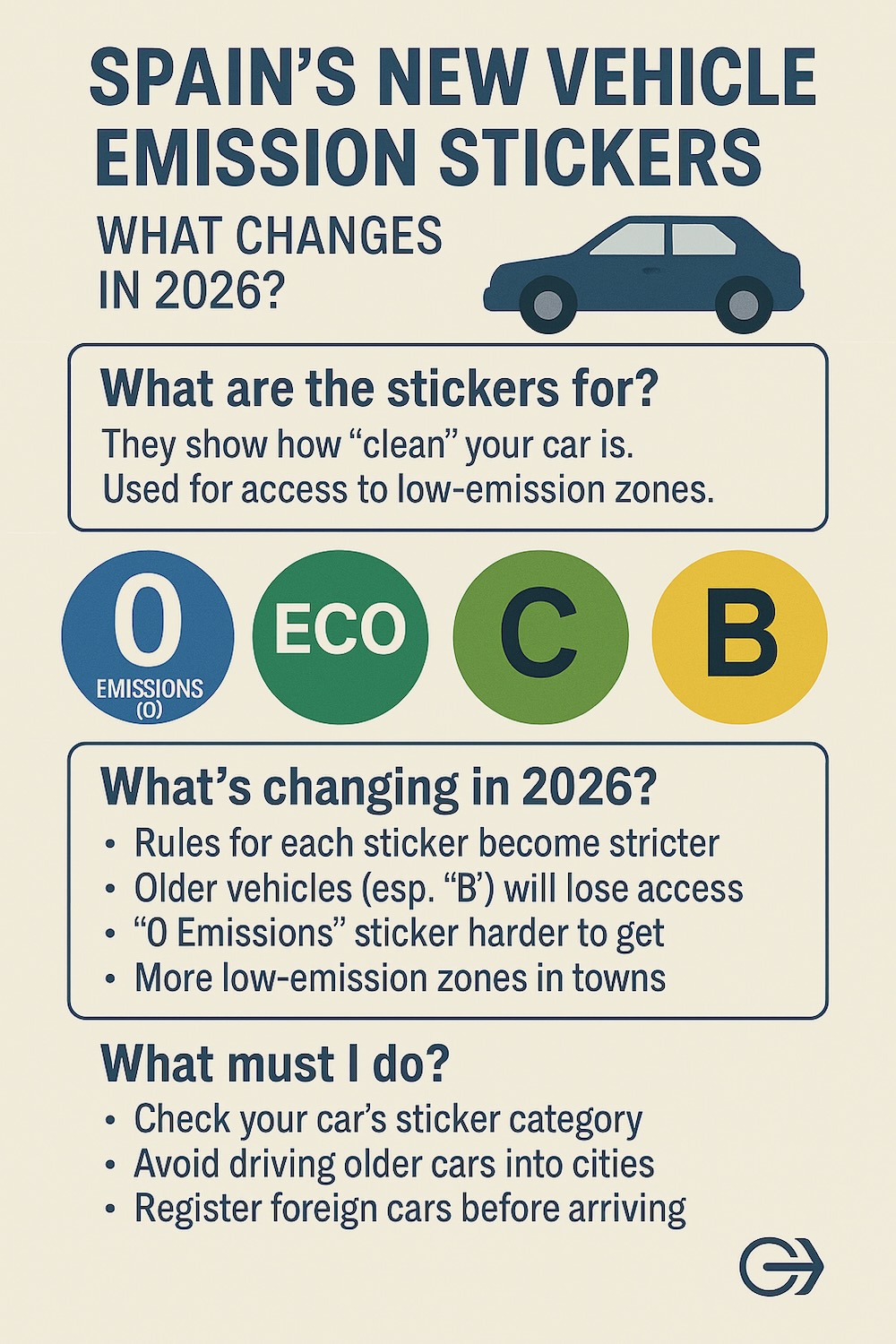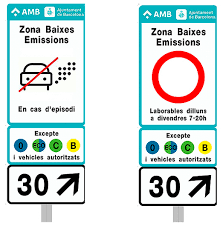NOVEMBER 2025
🚗 If you drive in Spain — whether you live there or just visit — you’ve probably seen the coloured round stickers on car windscreens.
They’re called DGT environmental stickers and they decide where you can drive in many towns and cities.
Here’s what’s changing — and what you really need to know.
🟢 What are these DGT stickers for?
They show how “clean” your car is — how much it pollutes.
Cities use them to control who can enter low-emission zones (Zonas de Bajas Emisiones, ZBE).
Cars with cleaner engines get more freedom to drive and park.
🔵 What are the sticker types?
There are still four main categories — these stay the same in 2026:
- 0 Emissions (Blue) – fully electric or hydrogen cars, or plug-in hybrids with very long electric range.
- ECO (Blue & Green) – hybrids or gas vehicles that meet modern standards.
- C (Green) – petrol and diesel cars that meet recent Euro 6 standards.
- B (Yellow) – older vehicles (Euro 4 petrol or Euro 6 diesel).
If your car is older than these categories, it has no sticker and cannot enter most city centres.
⚙️ So what’s changing in 2026?
- The rules for each sticker become stricter — based on newer and more realistic pollution tests.
- Some cars may lose their current label (for example, an “ECO” may drop to “C”).
- The DGT will only give the “0” sticker to vehicles that can run mainly on electricity.
- Older petrol and diesel cars (B label) will face more bans in city areas.
- More towns across Spain must now create low-emission zones.
🚫 Which vehicles will start to be banned?
- “A” or no-label vehicles are already banned in most cities.
- “B” label cars will gradually lose access — in some cities from 2026, and in others by 2028.
- “C” and “ECO” vehicles will still be allowed but may face some limits during pollution peaks.
🏙️ Which cities will tighten rules first?
- Madrid – already restricts older “B” and “C” cars in several areas.
- Barcelona – plans to ban all “B” label cars by 2028.
- Málaga and other Andalusian towns – new restrictions start late 2026.
- Many more medium-sized towns must introduce zones by 2026.
🌍 What if my car is registered abroad (for example, in France)?
You can still drive in Spain — but:
- Your car must meet the same emission standards as Spanish ones.
- You may need to register online before entering a low-emission zone (especially Madrid or Barcelona).
- If your car is old, you could be fined — even if it’s legal at home.
🧾 How can I check my sticker or category?
- Visit the official DGT website or ask at a Spanish post office (Correos).
- You can look up your car by registration number to see which label it qualifies for.
- Stickers are inexpensive (around €5) and can be ordered online or bought at post offices.
🕐 What should I do before 2026?
- Check your car’s sticker category now.
- If you plan to buy a new or used car in Spain, aim for an ECO or Zero Emissions model — it’s future-proof.
- Avoid driving older B or no-label cars into city centres — fines can start around €200.
- Register your vehicle if it’s foreign before entering a city’s ZBE.
💡 Why is Spain doing this?
Spain, like most EU countries, is cutting urban pollution to improve air quality and public health. The new rules make sure that cars’ stickers reflect their real emissions, not outdated lab tests.
✅ In short
- Stickers stay the same colours but the rules get tighter.
- Older vehicles (especially “B”) will lose city access step by step.
- 2026 is when the new criteria start.
- Check your car early, especially if you drive to Spain from abroad.



It’s my understanding that these stickers are only available for vehicles registered in Spain (the website doesn’t accept vehicle registration numbers which are not in the Spanish format). A French Crit’Air sticker is acceptable apparently. The Spanish authorities have yet to resolve the problem of foreign registered vehicles.
Perhaps you can clarify if my french badge can be used in spain or do I need another one. Also which citées are controlled I asked Barcelone and it is not clear as week-ends are excluded.